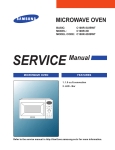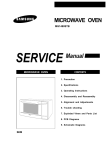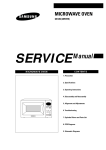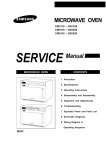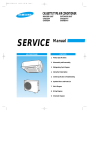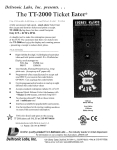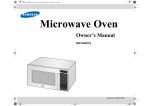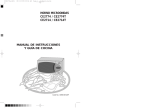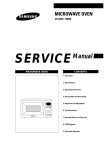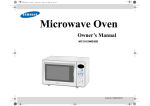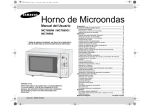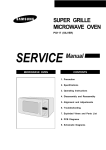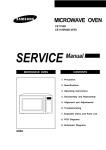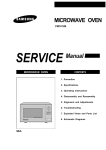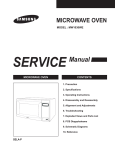Download Samsung MC1015BB Specifications
Transcript
MICROWAVE OVEN
MC1015WB
MC1015BB
SERVICE
MICROWAVE OVEN
Manual
CONTENTS
1. Precaution
2. Specifications
3. Operating Instructions
4. Disassembly and Reassembly
5. Alignment and Adjustments
6. Troubleshooting
7. Exploded Views and Parts List
8. PCB Diagrams
9. Schematic Diagrams
SEA
SAM0012
PRECAUTIONS TO BE OBSERVED BEFORE AND
DURING SERVICING TO AVOID POSSIBLE
EXPOSURE TO EXCESSIVE MICROWAVE ENERGY
(a) Do not operate or allow the oven to be
operated with the door open.
(b) Make the following safety checks on
all ovens to be serviced before activating
the magnetron or other microwave
source, and make repairs as necessary:
(1) Interlock operation,
(2) proper door closing,
(3) seal and sealing surfaces (arcing,
wear, and other damage),
(4) damage to or loosening of hinges
and latches,
(5) evidence of dropping or abuse.
(c) Before turning on microwave power
for any service test or inspection within
the microwave generating
compartments, check the magnetron,
wave guide or transmission line, and
cavity for proper alignment, integrity,
and connections.
(d) Any defective or misadjusted
components in the interlock, monitor,
door seal, and microwave generation
and transmission systems shall be
repaired, replaced, or adjusted by
procedures described in this manual
before the oven is released to the
owner.
(e) A Microwave leakage check to verify
compliance with the Federal
performance standard should be
performed on each oven prior to
release to the owner.
1. Precaution
Follow these special safety precautions. Although the microwave oven is completely safe during ordinary use,
repair work can be extremely hazardous due to possible exposure to microwave radiation, as well as potentially
lethal high voltages and currents.
1-1 Safety precautions (
1.
)
All repairs should be done in accordance
with the procedures described in this
manual. This product complies with
Federal Performance Standard 21 CFR
Subchapter J(DHHS).
11. To avoid any possible radiation hazard,
replace parts in accordance with the wiring
diagram. Also, use only the exact
replacements for the following parts:
Primary and secondary interlock switches,
interlock monitor switch.
2. Microwave emission check should be
performed to prior to servicing if the oven is
operative.
12. If the fuse is blown by the Interlock Monitor
Switch: Replace all of the following at the
same time: Primary, door sensing switch
and power relay, as well as the Interlock
Monitor Switch. The correct adjustment of
these switches is described elsewhere in this
manual. Make sure that the fuse has the
correct rating for the particular model being
repaired.
3. If the oven operates with the door open :
Instruct the user not to operate the oven and
contact the manufacturer and the center for
devices and radiological health immediately.
4. Notify the Central Service Center if the
microwave leakage exceeds 5 mW/cm2.
13. Design Alteration Warning:
Use exact replacement parts only, i.e.,
only those that are specified in the
drawings and parts lists of this manual.
This is especially important for the
Interlock switches, described above.
Never alter or add to the mechanical or
electrical design of the MWO. Any design
changes or additions will void the
manufacturer’s warranty. Always unplug
the unit’s AC power cord from the AC
power source before attempting to
remove or reinstall any component or
assembly.
5. Check all grounds.
6. Do not power the MWO from a "2-prong"
AC cord. Be sure that all of the built-in
protective devices are replaced. Restore any
missing protective shields.
7. When reinstalling the chassis and its
assemblies, be sure to restore all protective
devices, including: nonmetallic control
knobs and compartment covers.
14. Never defeat any of the B+ voltage
interlocks. Do not apply AC power to the
unit (or any of its assemblies) unless all
solid-state heat sinks are correctly installed.
8. Make sure that there are no cabinet openings
through which people --particularly
children --might insert objects and contact
dangerous voltages. Examples: Lamp hole,
ventilation slots.
15. Some semiconductor ("solid state") devices
are easily damaged by static electricity. Such
components are called Electrostatically
Sensitive Devices (ESDs). Examples include
integrated circuits and field -effect transistors.
Immediately before handling any
semiconductor components or assemblies,
drain the electrostatic charge from your
body by touching a known earth ground.
9. Inform the manufacturer of any oven found
to have emission in excess of 5 mW/cm2 ,
Make repairs to bring the unit into
compliance at no cost to owner and try to
determine cause.
Instruct owner not to use oven until it has
been brought into compliance.
16. Always connect a test instrument’s ground
lead to the instrument chassis ground before
connecting the positive lead; always remove
the instrument’s ground lead last.
CENTRAL SERVICE CENTER
10. Service technicians should remove their
watches while repairing an MWO.
1-2 Special Servicing Precautions (Continued)
17. When checking the continuity of the witches
or transformer, always make sure that the
power is OFF, and one of the lead wires is
disconnected.
18. Components that are critical for safety are
indicated in the circuit diagram by
shading,
or
.
19. Use replacement components that have the
same ratings, especially for flame resistance
and dielectric strength specifications. A
replacement part that does not have the
same safety characteristics as the original
might create shock, fire or other hazards.
1-3 Special High Voltage Precautions
1. High Voltage Warning
Do not attempt to measure any of the high
voltages --this includes the filament voltage
of the magnetron. High voltage is present
during any cook cycle.
Before touching any components or wiring,
always unplug the oven and discharge the
high voltage capacitor (See Figure 1-1)
H. V. Capacitor
2. The high-voltage capacitor remains charged
about 30 seconds after disconnection. Short
the negative terminal of the high-voltage
capacitor to to the oven chassis. (Use a
screwdriver.)
3. High voltage is maintained within specified
limits by close-tolerance, safety-related
components and adjustments. If the high
voltage exceeds the specified limits, check
each of the special components.
H. V. Diode
Short
Touch chassis ground first then short to the high
voltage capacitor terminal by using screwdriver or
jumper wire.
Fig. 1-1 Discharging High Voltage Capacitor
PRECAUTION
There exists HIGH VOLTAGE ELECTRICITY
with high current capabilities in the circuits of the
HIGH VOLTAGE TRANSFORMER secondary
and filament terminals. It is extremely dangerous
to work on or near these circuits with the oven
energized.
DO NOT measure the voltage in the high voltage
circuit including filament voltage of magnetron.
PRECAUTION
Never touch any circuit wiring with your hand nor
with uninsulated tool during operation.
PRECAUTION
Servicemen should remove their watches
whenever working close to or replacing the
magnetron.
2. Specifications
2-1 Table of Specifications
TIMER
99 MINUTES 99SECONDS
POWER SOURCE
120V 60Hz, AC
POWER CONSUMPTION
MICROWAVE : 1,500W
CONVECTION : 1600W
OUTPUT POWER
FROM 100 TO 1000W(10 LEVEL POWER)
(IEC-705 TEST PROCEDURE)
OPERATING FREQUENCY
2,450MHz
MAGNETRON
OM75P(31)
COOLING METHOD
COOLING FAN MOTOR
OUTSIDE DIMENSIONS
625(W) x 390(H) x 575(D)mm
NET WEIGHT
26.0 kg
SHIPPING WEIGHT
28.0 kg
3. Operating Instructions
3-1 Control Panel
Clock
Sets current time.
Help
Press to see help information
about the feature you are using.
One Minute+
Press once for every minute
of cooking at High Power
Instant Cook Buttons
Instant settings to cook popular f oods.
Auto Cook
Press to select Auto cook and weight.
Combo
Press to cook oven automatically cycles
between microwave and convection cooking.
Preheat
Press to preheat at desired temper ature.
Conv. / F
Press to brown and cook quickly
with circulated hot air.
Broil
Please to brown and cook.
Power Level
Press this pad to set a power level other than high.
Auto Reheat
Shows type and quantity of food to be reheated.
More/Less
Increase or decrease cooking time .
Auto Defrost
Sets weight of food to be defrosted.
Number Buttons
Sets cooking times or amounts and
power levels other than high.
My Choice
Press to set non-cooking feature.
Kitchen Timer
Sets kitchen or convenience timer.
Start
Press to start cooking.
Pause/Cancel
Press to pause oven or correct a mistake.
3-2 Features & External Views
Door
Ventilation Holes
Light
Ventilation Holes
Control Panel
Guide Roller
Glass Plate
Coupler
Metal Rack
320mm
Door Latches
231.5mm
401.5mm
556mm
544.5mm
4. Disassembly and Reassembly
4-1 Replacement of Magnetron, Motor Assembly and Lamp
Cover Air
Remove the magnetron including the shield case,
permanent magnet, choke coils and capacitors (all
of which are contained in one assembly).
1. Disconnect all lead wires from the magnetron
and lamp.
2. Remove the bracket mounting.
3. Remove the magnetron supporter.
4. Remove the air cover.
5. Remove screws securing the magnetron to the Magnetron
wave guide.
6. Take out the magnetron very carefully.
7. Remove screws from the back panel.
8. Take out the fan motor.
9. Remove the oven lamp by rotating to pull out from
hole of air cover.
Thermo S/W
Fan Motor
H. V. Trans
Screw
H.V Capacitor
NOTE1: When removing the magnetron, make sure that its antenna does not hit any adjacent parts, or it
may be damaged.
NOTE2: When replacing the magnetron, be sure to remount the magnetron gasket in the correct position and
make sure the gasket is in good
4-2 Replacement of High Voltage Transformer
1.
2.
3.
4.
Discharge the high voltage capacitor.
Disconnect all the leads.
Remove the mounting bolts.
Reconnect the leads correctly and firmly.
PRECAUTION
Servicemen should remove their watches
whenever
working close to or replacing the magnetron.
PRECAUTION
There exists HIGH VOLTAGE ELECTRICITY with
high current capabilities in the circuits of the
HIGH
VOLTAGE TRANSFORMER secondary and
filament terminals. It is extremely dangerous to
work on or near these circuits with the oven
energized.
DO NOT measure the voltage in the high voltage
circuit including filament voltage of magnetron.
4-3 Replacement of Door Assembly
4-3-1 Removal of Door Assembly
4-3-4 Removal of Key Door &Spring
securing the upper hinge and lower hinge.
The remove door assembly.
Remove pin hinge from Door "E"
Datach spring from Door "E" and key door.
Upper Hinge
Door "E"
Screws
Low Hinge
Key Door
Screws
Spring
4-3-2 Removal of Door "C"
4-3-5RemovalofScreen-Door&Deco-Door
Insert flat screwdriver into the gap between Door
"A" and Door "C" to remove Door "C". Be careful
when handling Door "C" because it is fragile.
1. Remove Door "E" from Door "A"
2. Remove Door-Screen"B" and Deco Door.
Deco-Door
Door "C"
Door "A"
4-3-3 Removal of Door "E"
Following the procedure as shown in the figure,
insert and bend a thin metal plate between Door
"E" and Door "A" until you hear the ’tick’ sound.
1. Insertion depth of the thin metal plate should be
0.5mm or less.
Door "E"
4-3-6 Reassembly Test
After replacement of defective component parts of the door, reassemble it and follow the instructions
below for proper installation and adjustment so as to prevent an excessive microwave leakage.
1. When mounting the door to the oven, be sure to adjust the door parallel to the bottom line of the
oven face plate by moving the upper hinge and lower hinge in the direction necessary for proper
alignment.
2. Adjust so that the door has no play between the inner door surface and oven front surface. If the door
assembly is not mounted properly, microwave energy may leak from the space between the door and oven.
3. Do microwave leakage test.
4-4 Replacement of Fuse
1. Disconnect the oven from the power source.
2. When 20A fuse blows out by the operation of interlock monitor switch failure, replace the primary interlock
switch, door sensing switch, monitor switch and power relay.
3. When the above three switches operate properly, check if any other part such as the control circuit board,
blower motor or high voltage transformer is defective.
4-5 Replacement of Drive Motor
1. Take out the glass tray, guide roller and coupler
from cavity.
2. Turn the oven upside down to replace the drive motor.
Screw
3. Remove a screw securing the drive motor cover.
Drive Motor
4. Disconnect all the lead wires from the drive motor.
5. Remove screws securing the drive motor to the cavity.
6. Remove the drive motor.
7. When replacing the drive motor, be sure to
remount it in the correct position.
8. Connect all the leads to the drive motor.
Base Plate
Drive Motor Cover
9. Screw the drive motor cover to the base plate
with a screw driver.
4-6 Replacement of Control Circuit Board
1. Be sure to disclyarge any static electricity from
your body, and avoid touching the "touch
control" circuitry.
2. Disconnect the connectors from the control
circuit board.
3. Remove screws securing the control box
assembly.
4. Lift up the control circuit board from right side
and remove the hooks holding the control
circuit board to the box assembly.
SCREWS
5. Alignment and Adjustments
PRECAUTION
1. High voltage is present at the high voltage terminals during any cook cycle.
2. It is neither necessary nor advisable to attempt measurement of the high voltage.
3. Before touching any oven components or wiring, always unplug the oven from its power source and
discharge the high voltage capacitor.
5-1 High Voltage Transformer
1. Remove connectors from the transformer terminals
and check continuity.
2. Normal resistance readings are as follows:
Filament Terminals
SHV-U11KA
Secondary
7510%
Filament
Shows Continuity
Primary
0.3010%
Primary
Terminals
(Room temperature = 20° C)
5-2 Low Voltage Transformer
1. The low voltage transformer is located on the
Assy base plate.
2. Remove the low voltage transformer from the
Assy base plate and check continuity.
3. Normal resistor reading is shown in the table.
Terminals
1~2(Input)
Resistance
250Ω.
3~4(Output)
9Ω..
5~6(Output)
1.0Ω.
5-3 Magnetron
1. Continuity checks can indicate only an open
filament or a shorted magnetron. To diagnose an
open filament or shorted magnetron :
2. Isolate the magnetron from the circuit by
disconnecting its leads.
3. A continuity check across the magnetron filament
terminals should indicate one ohm or less.
4. A continuity check between each filament terminal
and magnetron case should read open.
Magnetron Antenna
Cooling Fins
Gasket Plate
5-4 High Voltage Capacitor
1.
2.
3.
4.
5.
Check continuity of the capacitor with the meter set at the highest resistance scale.
Once the capacitor is charged, a normal capacitor shows continuity for a short time, and then indicates 9M.
A shorted capacitor will show continuous continuity.
An open capacitor will show constant 9M.
Resistance between each terminal and chassis should read infinite.
5-5 High Voltage Diode
1. Isolate the diode from the circuit by disconnecting its leads.
2. With the ohm-meter set at the highest resistance scale, measure across the diode terminals. Reverse the
meter leads and read the resistance. A meter with 6V, 9V or higher voltage batteries should be used to
check the front-to back resistance of the diode (otherwise an infinite resistance may be read in both
directions). The resistance of a normal diode will be infinite in one direction and several hundred Kin the
other direction.
5-6 Main Relay and Power Control Relay
1. The relays are located on the PCB Ass’y. Isolate them from the main circuit by disconnecting the leads.
2. Operate the microwave oven with a water load in the oven. Set the power level set to high.
3. Check continuity between terminals of the relays after the start pad is pressed.
5-7 Adjustment of Primary Switch, Door Sensing Switch and Monitor Switch
Precaution
For continued protection against radiation hazard, replace parts in accordance with the wiring diagram and be sure to
use the correct part number for the following switches: Primary and secondary interlock switches, and the interlock
monitor switch (replace all together). Then follow the adjustment procedures below. After repair and adjustment, be
sure to check the continuity of all interlock switches and the interlock monitor switch.
1. When mounting Primary switch and Interlock
Monitor switch to Latch Body, consult the figure.
2. No specific adjustment during installation of
Primary switch and Monitor switch to the latch
body is necessary.
3. When mounting the Latch Body to the oven
assembly, adjust the Latch Body by moving it so
that the oven door will not have any play in it.
Check for play in the door by pulling the door
assembly. Make sure that the latch keys move
smoothly after adjustment is completed.
Completely tighten the screws holding the Latch
Body to the oven assembly.
Secondary
Interlock Switch
Body Latch
Interlock Monitor
Switch
Lever Switch
4. Reconnect to Monitor switch and check the
continuity of the monitor circuit and all latch
switches again by following the components test
procedures.
5. Confirm that the gap between the switch
housing and the switch actuator is no more than
0.5mm when door is closed.
6. Interlock Switch Replacement - When
replacing faulty switches, be sure switch mounting
tabs are not bent, broken or otherwise deficient in
their ability to secure the switches in place.
Door Sensing Switch
(Primary Interlock)
Door Open Door Closed
Primary switch
∞
0
Monitor switch(COM-NC)
0
∞
Door Sensing S/W
∞
0
5-8 Output Power of Magnetron
CAUTION
MICROWAVE RADIATION
PERSONNEL SHOULD NOT ALLOW EXPOSURE TO MICROWAVE RADIATION FROM MICROWAVE
GENERATOR OR OTHER PARTS CONDUCTING MICROWAVE ENERGY.
The output power of the magnetron can be measured by performing a water temperature rise test.
Equipment needed :
* Two 1-liter cylindrical borosilicate glass vessel (Outside diameter 190 mm)
* One glass thermometer with mercury column
NOTE: Check line voltage under load. Low voltage will lower the magnetron output. Make all temperature
and time tests with accurate equipment.
1. Fill the one liter glass vessel with water.
2. Stir water in glass vessel with thermometer, and record glass vessel’s temperature ("T1", 10±1° C).
3. After moving the water into another glass vessel, place it in the center of the cooking tray. Set the oven to
high power and operate for 44 seconds exactly. (1.5 seconds included as a holding time of magnetron
oscillation:)
4. When heating is finished, stir the water again with the thermometer and measure the temperature ("T2").
5. Subtract T1 from T2. This will give you the water temperature rise. (T)
6. The output power is obtained by the following formula;
Output Power =
4.187 x 1000 x T + 0.88 x Mc x(T2-T0)
41
41 : Heating Time (sec)
4.187 : Coefficient for Water
1000 : Water (cc)
T : Temperature Rise (T1-T2)
Mc : Cylindrical borosilicate glass weight
To : Room Temperature
7. Normal temperature rise for this model is 9°C to 11° C at 'HIGH'.
NOTE 1: Variations or errors in the test procedure will cause a variance in the temperature rise.
Additional power test should be made if temperature rise is marginal.
NOTE 2: Output power in watts is computed by multiplying the temperature rise (step E) by a factor of 91
times the of centigrade temperature.
5-9 Procedure for Measurement of Microwave Energy Leakage
1) Pour 275±15cc of 20±5° C(68±9° F) water in a beaker
which is graduated to 600cc, and place the beaker in
the center of the oven.
2) Start to operate the oven and measure the leakage by
using a microwave energy survey meter.
3) Set survey meter with dual ranges to 2,450MHz.
4) When measuring the leakage, always use the 2 inch
spacer cone with the probe. Hold the probe
perpendicular to the cabinet door. Place the spacer
cone of the probe on the door and/or cabinet door
seam and move along the seam, the door viewing
window and the exhaust openings moving the
probe in a clockwise direction at a rate of 1 inch/sec. If the leakage testing of the cabinet door seam is
taken near a corner of the door, keep the probe perpendicular to the areas making sure that the probe end
at the base of the cone does not get closer than 5cm to any metal. If it gets closer than 5cm, erroneous
readings may result.
5) Measured leakage must be less than 4mW/cm2 , after repair or adjustment.
Maximum allowable leakage is 5mW/cm2 .
4mW/cm2 is used to allow for measurement and meter accuracy
5-10 Check for Microwave Leakage
1. Remove the outer panel.
2. Pour 275±15cc of 20±5°C(68±9°F) water in a beaker
which is graduated to 600cc, and place the beaker in
the center of the oven.
3. Start the oven at the highest power level.
4. Set survey meter dual ranges to 2,450MHz.
5. Using the survey meter and spacer cone as described
above, measure near the opening of magnetron, the
surface of the air guide and the surface of the wave
guide as shown in the following photo.( but avoid the
high voltage components.) The reading should be
less than 4mW/cm 2 .
WARNING
AVOID THE HIGH VOLTAGE COMPONENTS
5-11 Note on Measurement
1) Do not exceed the limited scale.
2) The test probe must be held on the grip of the handle, otherwise a false reading may result when the
operator's hand is between the handle and the probe.
3) When high leakage is suspected, do not move the probe horizontally along the oven surface; this may
cause damage to the probe.
4) Follow the recommendation of the manufacturer of the microwave energy survey meter.
5-12 Leakage Measuring Procedure
5-12-1 Record keeping and notification after measurement
1) After adjustment and repair of a radiation preventing device, make a repair record for the measured
values, and keep the data.
2) If the radiation leakage is more than 4 mW/cm2 after determining that all parts are in good condition,
functioning properly and the identical parts are replaced as listed in this manual notify that fact to ;
CENTRAL SERVICE CENTER
5-12-2 At least once a year have the microwave energy survey meter checked for accuracy by its manufacturer.
6. Troubleshooting
PRECAUTION
1.
2.
3.
4.
CHECK GROUNDING BEFORE CHECKING FOR TROUBLE.
BE CAREFUL OF THE HIGH VOLTAGE CIRCUIT.
DISCHARGE THE HIGH VOLTAGE CAPACITOR.
WHEN CHECKING THE CONTINUITY OF THE SWITCHES OR TRANSFORMER, DISCONNECT
ONE LEAD WIRE FROM THESE PARTS AND THEN CHECK CONTINUITY WITHOUT THE
POWER SOURCE ON. TO DO OTHERWISE MAY RESULT IN A FALSE READING OR DAMAGE
TO YOUR METER.
5. DO NOT TOUCH ANY PART OF THE CIRCUIT OR THE CONTROL CIRCUIT BOARD, SINCE
STATIC DISCHARGE MAY DAMAGE IT.
ALWAYS TOUCH GROUND WHILE WORKING ON IT TO DISCHARGE ANY STATIC CHARGE
BUILT UP.
6-1 Electrical Malfunction
SYMPTOM
CAUSE
CORRECTIONS
Oven is dead.
1. Open or loose lead wire harness
Fuse is OK.
2. Open thermal cutout (Magnetron)
No display and no operation at all. 3. Open low voltage transformer
4. Defective Ass’y PCB
Check fan motor when thermal
cutout is defective.
Check Ass’y PCB when L.V.T
is defective.
No display and no operation at all. 1. Shorted lead wire harness
2. Defective primary latch switch
Fuse is blown.
(NOTE 1)
3. Defective monitor switch (NOTE1)
4. Shorted H.V.Capacitor
5. Shorted H.V.Transformer (NOTE2)
Check adjustment of primary,
interlock monitor,
power relay, door sensing
switch.
NOTE 1: All of these switches must be replaced at the same time.
(refer to adjustment instructions)
Check continuity of power relay contacts and if it has
continuity, replace power relay also.
NOTE 2: When H.V.Transformer is replaced, check diode and
magnetron also.
Oven does not accept
key input (Program)
1. Key input is not in-Sequence
2. Open or loose connection of
membrane key pad to Ass’y PCB
3. Shorted or open membrane panel
4. Defective Ass’y PCB
1. Off-alignment of latch switches
2. Open or loose connection of high
voltage circuit especially
magnetron filament circuit
NOTE: Large contact resistance will
bring lower magnetron
filament voltage and cause
Timer starts countdown but no
magnetron to lower output
microwave oscillation.
and/or intermittent oscillation.
(No heat while oven lamp and fan
3. Defective high voltage
motor turn on.)
components H.V.Transformer
H.V. Capacitor
H.V.Diode, H.V.Fuse
Magnetron
4. Open or loose wiring of power relay
5. Defective primary latch switch
6. Defective power relay or Ass’y PCB
Refer to operation procedure.
Replace PCB main.
Adjust door and latch switches.
Check high voltage component
according to component test
procedure and replace if it is
defective.
Replace PCB main.
6-1 Electrical Malfunction(continued)
SYMPTOM
CAUSE
Oven lamp and fan motor turn on
1. Misadjustment or loose wiring
of primary latch switch
2. Defective primary latch switch
Oven can program but timer
does not start.
1. Open or loose wiring of
secondary interlock switch
2. Off-alignment of primary
interlock
3. Defective secondary interlock S/W
Microwave output is low;.
Oven takes longer time to
cook food.
1. Decrease in power source
voltage.
2. Open or loose wiring of
magnetron filament circuit.
(Intermittent oscillation))
3. Aging of magnetron
CORRECTIONS
Adjust door and latch switches.
Adjust door and interlock switches.
Consult electrician.
Fan motor turns on when plugged in Loose wiring of door sensing switch Check wire of door sensing switch.
Oven does not operate and return to Defective Ass’y PCB
the plugged in mode.
Replace PCB main.
Loud buzzing noise can be heard.
1. Loose fan and fan motor
2. Loose screws on
H.V.Transformer
3. Shorted H.V.Diode
Turntable motor does not rotate.
1. Open or loose wiring of
turntable motor.
2. Defective turntable motor.
Replace turntable motor.
Oven stops operation during
cooking
1. Open or loose wiring of primary
interlock switch
2. Operation of thermal
cutout(Magnetron)
Adjust door and latch switches.
Sparks
1. Metallic ware or cooking dishes
touching on the oven wall.
2. Ceramic ware trimmed with
gold or silver powder also
causes sparks.
Inform the customer.
Do not use any type of cookware
with metallic trimming.
Uneven cooking
Noise from the turntable motor
when it starts to operate.
Tighten screws of fan motor.
Tighten screws of H.V.Transformer.
Replace H.V.Diode.
Uneven intensity of microwave due
Wrap thinner parts of the food with
to its characteristics.
aluminum foil.
Use plastic wrap or cover with a lid.
Stir once or twice while cooking
foods such as soup, cocoa, or milk.
Noise may result from the motor.
Replace turntable motor.
7. Exploded Views and Parts List
7-1 Exploded Views
MM73
MM52
MM01
MM581
MM67
MM42
MM07
MM59
MM25
MM65
MM55
MM34
MM03
MM35
MM06
MD01
MM71
MM17
MM56
MC01
MM10
MB01
MM16
MB03
MM53
MM28
MM22
MM08
MM102
MB05
MB10
MB02
MM14
MM09
MB041
MM18
MB03 MB042
MM29
MM64
MM19
MM30
MM20
MM31
MM27
MM93
MM64
7-2 Main Parts List
S.N.A : SERVICE NOT AVAILABLE
No.
Code No.
MB01
DE96-00120F
ASSY BODY LATCH
Description
MW880BKA/XAA,HANDLE ALL1
Specification
Q’ty
1
MB02
3405-001033
SWITCH-MICRO
125/250VAC,16A,200GF,SPST-N
1
MONITOR
MB03
3405-001034
SWITCH-MICRO
125/250VAC,16A,200GF,SPST-N
2
DOOR,PRI
MB041
DE66-00093A
LEVER-SWITCH(A)
NC2000,PP-TH53,-,-,-,-,N
1
MB042
DE66-00094A
LEVER-SWITCH(B)
NC2000,PP-TH53,-,-,-,-,N
1
MB05
DE72-00137A
BODY-LATCH
NC2000(0.6/0.8/1.2),PP,-,-,-,
1
MB10
DE66-00117A
LATCH-STOPPER
MW1480STA,PP,-,-,-,-,-
1
MC01
-
ASSY CONTROL-BOX
120V60HZ,MC1015WB/XAA,P
1
MD01
DE94-00644F
ASSY DOOR
MC1015WB,-,CONVECTION
1
MM01
DE70-00302M
PANEL-OUTER
MC1015WB,SECC,T0.6,W360,L112
1
MM03
DE96-00221A
ASSY-WIRE HARNESS-A
MC1015WB/XAA,120V60H
1
MM06
DE31-00001G
ASSY-MOTOR FAN
SMF-789UA2,120V60HZ,2650R
1
MM07
DE96-00222A
ASSY-POWER CORD
MC1015WB,120V60HZ,AWG14,
1
MM08
OM75P(31)ESS
ASSY-MAGNETRON
OM75P(31)ESS
1
MM09
DE71-60016D
COVER-AIR
CK95,NYLYN#66(TEFRON523),-,-,-
1
MM10
4713-001012
LAMP-INCANDESCENT
130V,-,40W,ORG,B/L,-,2
1
MM14
DE26-00061B
TRANS-H.V
SHV-U11KA_R,120V,60HZ,2300V/3.
1
MM16
DE71-00015A
COVER-CEILING
CE2933,-,T0.3,W114.2,L121.
1
MM17
DE47-20009A
THERMOSTAT
PW2N-520PB,160/60,250V/7.5A,H
1
MM18
DE74-20015G
TRAY-COOKING
-,T6,-,-
1
MM19
DE92-90189U
ASSY-GUIDE ROLLER
1.0CUFT(PPS)15.5,-,-,-
1
MM20
DE67-60081A
COUPLER
PPS,-,-,BROWN,3RD-1.0/1.3,-
1
MM22
DE31-10104A
MOTOR SYNCHRONOUS
M2CK29Z709-H,120V60HZ,
1
MM27
DE61-40065A
FOOT
-,PP,T2x22x17mm,BLK,-,-,-
4
MM28
DE80-10001R
BASE-PLATE
3RD(1.0-NEW),SGCC,T0.8,W345,L
1
MM29
2501-001016
C-OIL
950nF,2.1KV,BK,35x54x80,20mm
1
MM30
DE61-50106A
BRACKET-HVC
-,SECC,T0.8,W31,L125.8,-,-
1
MM31
DE91-70063A
ASSY-HVD
V2M6,PI9.0,0.05MT,-,-
1
MM34
3602-001025
FUSE-HOLDER
300V,30A,20mohm
1
MM35
DE32-10013B
SENSOR-THERMISTOR
PT-312-K2,MC1015WB,LON
1
MM42
DE39-00220A
WIRE HARNESS-B
MC7698W/XAA,-,-,-,-,-,-,-
1
MM52
DE63-90035H
CUSHION-RUBBER
-,DFA20,T2,W190,L200,-,-
1
MM53
DE64-00131C
FILM-LAMP
-,MC1015WB/BB,PET,T0.11,W70,L1
1
MM55
3601-001198
FUSE-CARTRIDGE
250V,20A,SLOW-BLOW,CERAMIC
MM56
DE92-90555D
ASSY-COVER ADIA(R)
C100,CONV,-,-
1
MM581
DE71-60459B
COVER-ADIABATIC(L)
NC2000(1.0CU.FT),SECC
1
MM59
DE71-60448D
COVER-BACK
MC1015WB/XAA,ALCOAT,T0.6,-,-,
1
MM64
DE97-00136B
ASSY-WIRE RACK
CK95,LOW-RACK,-,-,-,-
1
MM64
DE97-00136E
ASSY-WIRE RACK
MG104WA,114,FOOT,VE-TYPE
1
MM65
DE72-60035R
GUIDE-AIR
CK135,SECC,T0.5,-,-,-
1
MM67
DE61-50565A
BRACKET-UPPER
-,SECC,T0.5,W362,L294,-,-
1
MM71
DE61-50490A
BRACKET-TCO
-,SECC1,T0.6,34,58,-,-
1
MM73
-
ASSY-CASING
MC1015WB,120V60HZ,1580W,-
1
MM93
DE60-60025A
PIN-FOOT
PP-JI350,BLK,-,-,-,-,-,-
4
Remark
S.N.A
S.N.A
7-3 Door Parts List
MD08
MD06
MD04
MD09
MD17
MD02
MD07
MD10
MD29
MD15
No.
Code No.
Description
Specification
MD02
DE64-40319A
DOOR-A
CK95,PC,-,-,-,-,WHT,-
1
MD04
DE94-00075H
ASSY DOOR-E(SEALANT)
C100,SEALANT,3RD-1.
1
MD06
DE64-40012C
DOOR-C
CK95,PBT,-,-,-,-,BLK,-
1
MD07
DE61-00199A
SPRING-KEY
M1977,HSWR,D6,-,-,25 1/4,25 1
1
MD08
DE61-80002A
HINGE-UPPER
WHT,SHV-745CC1,SSEC,T2.3,26,
1
MD09
DE61-80003A
HINGE-LOWER
WHT,TN-5630T,SSEC,T2.3,26,77
1
MD10
DE64-00264B
KEY-DOOR
MC1015WB/BB,GLASS(GLASS0%),BLK,
1
MD15
DE64-90160A
DECORATION-DOOR
-,Y745STC,S7A77,-,-,-,-,
1
MD17
DE67-20184K
SCREEN-DOOR(B)
-,CK920T,TEMP GLASS,T3.2,
1
MD29
DE63-00024B
CUSHION-SCREEN
C100,CR,T2.0,W12,L150,BLK
2
Q’ty
Remark
7-4 Control Parts List
MC03
MC06
MC02
MC07
No.
Code No.
Description
Specification
MC02
DE34-00127A
SWITCH MEMBRANE
MC1015WB/XAA,2-TAIL,W90*
1
MC03
DE64-00707C
CONTROL-PANEL
MC1015,PC(V-0),WHT,-,-,-,-
1
MC06
DE67-40173B
WINDOW-DISPLAY
RE-MF70,SAN-20%(CR5381G01
1
MC07
RA-MC5694-05
ASSY PCB PARTS
MC1015WB/XAA,120V60HZ
1
Q’ty
Remark
7-5 Casing Parts List
MA01
MA03
MA02
MA09
MA07
MA02
MA05
MA06
MA04
MA08
No.
Code No.
Description
Specification
MA01
DE31-10171B
MOTOR-CONVECTION
SHC-5694UA,120V60HZ,-,3
1
MA02
DE31-90019A
BLADE-FAN
SECC,T0.6,-,-,-,-,-
1
MA02
DE31-90020A
BLADE-FAN
ALSTAR,T0.6,W250,L250,-,-,-
1
MA03
DE47-70077C
HEATER
SHC-5694U1,-,-,1580W,-,120V,-,-,-
1
MA04
DE60-40026B
WASHER-PLAIN
ID5.5,OD12,T1.0,SBC1,ZNC3,-
1
MA05
DE62-00098B
ADIABATIC-CASING
-,T8,W245,L336.8,CK95,-
1
MA06
DE72-30016A
BUSH-MOTOR
-,MSWR3,L11.2,D5.6,RE-1300,-,
1
MA07
DE92-90487A
ASSY-COVER CASING
CE115K,230V50HZ,-,-,-,
1
MA08
DE60-40014B
WASHER-C MOTOR
M16,T1.0,SECC,ZNC3,-,-,-,
1
MA09
DE61-50484A
BRACKET-HEATER
-,STS430,T0.8,W27.2,L26,C
2
Q’ty
Remark
7-6 Standard Parts List
Code No.
Description
Specification
Q’ty
Remark
DE60-20063A
BOLT-FLANGE
M4,10,ZPC3,YEL,MSWR,-,-,-,-
4
HING-L/U
DE60-30016A
NUT-FLANGE
M4,MSWR10,-,-,-,-,-,-,-
1
SENSOR
DE60-30016B
NUT-FLANGE
M4,MSWR10,FEFN,-,-,-,-,-,-
3
DE60-10082H
SCREW-A
-,-,-,-,2S-4X12,TOOTHED,-,-,-,-
5
P-OUTER
DE60-10018A
SCREW-ASSY MACHINE
-,WS,MSWR10,SN1,PH,M4X0.7P,-,8,-,-
2
B-EARTH
DE60-10098A
SCREW-ASSY TAP TITE
-,GLD,SWRCH18A,ZPC2,PH,TC,-,M4X8,WT,-
2
M-DRIVE
DE60-10098A
SCREW-ASSY TAP TITE
-,GLD,SWRCH18A,ZPC2,PH,TC,-,M4X8,WT,-
1
HVD
DE60-10052A
SCREW-TAP PH
-,-,FEFZY,-,PH,M4,-,L8,-,-
2
A-A-RIGHT
DE60-10053A
SCREW-TAP PH
-,-,FEFZY,-,PH,M4,-,L10,-,-
1
H/FUSE
DE60-10045A
SCREW-TAP PH
-,-,FEFZY,-,PH,M3,-,L6,-,-
1
DE60-10088A
SCREW-TAP PH
-,-,FEFZY,PLAIN,PH,M3,-,L8,-,-
2
DE60-10070A
SCREW-TAP TH
-,-,FEFZY,2-SLOT,TH,M4,-,L12,-,-
2
A-A-LEFT
DE60-10070A
SCREW-TAP TH
-,-,FEFZY,2-SLOT,TH,M4,-,L12,-,-
4
A-C-BACK
DE60-10070A
SCREW-TAP TH
-,-,FEFZY,2-SLOT,TH,M4,-,L12,-,-
3
A-CASING
DE60-10070A
SCREW-TAP TH
-,-,FEFZY,2-SLOT,TH,M4,-,L12,-,-
1
A-THERMO-G
DE60-10070A
SCREW-TAP TH
-,-,FEFZY,2-SLOT,TH,M4,-,L12,-,-
1
B-A-GUIDE
DE60-10070A
SCREW-TAP TH
-,-,FEFZY,2-SLOT,TH,M4,-,L12,-,-
2
B-LATCH
DE60-10070A
SCREW-TAP TH
-,-,FEFZY,2-SLOT,TH,M4,-,L12,-,-
1
B-UPPER
DE60-10070A
SCREW-TAP TH
-,-,FEFZY,2-SLOT,TH,M4,-,L12,-,-
1
C-AIR
DE60-10070A
SCREW-TAP TH
-,-,FEFZY,2-SLOT,TH,M4,-,L12,-,-
2
C-BOX
DE60-10070A
SCREW-TAP TH
-,-,FEFZY,2-SLOT,TH,M4,-,L12,-,-
2
M-FAN
DE60-10122A
SCREW-TAP TH
-,-,FE,FN,TAP,TH,-,2-4X8,-,-
2
C-CEILING
DE60-10122A
SCREW-TAP TH
-,-,FE,FN,TAP,TH,-,2-4X8,-,-
3
B-C-MOTOR
DE60-10122A
SCREW-TAP TH
-,-,FE,FN,TAP,TH,-,2-4X8,-,-
2
BKT-HEATER
DE60-10122A
SCREW-TAP TH
-,-,FE,FN,TAP,TH,-,2-4X8,-,-
4
CV-CAS
DE60-10012A
SCREW-TAP TITE
-,SWR10,M4,L10,TH,+,-,3,ZPC2,-
1
A-P-CORD
DE60-10012A
SCREW-TAP TITE
-,SWR10,M4,L10,TH,+,-,3,ZPC2,-
3
B-PLATE
DE60-10012A
SCREW-TAP TITE
-,SWR10,M4,L10,TH,+,-,3,ZPC2,-
1
C-B-EARTH
DE60-10012A
SCREW-TAP TITE
-,SWR10,M4,L10,TH,+,-,3,ZPC2,-
1
DE60-10034A
SCREW-TH
-,-,L10,STS304,TH,+,-,M4,-,-
1
SENSOR
DE60-10080B
SCREW-WASHER
-,2S,SWRCH18A,ZP2,PH,PI5,-,L10,-,-
4
MAGNETRON
DE60-10080B
SCREW-WASHER
-,2S,SWRCH18A,ZP2,PH,PI5,-,L10,-,-
4
TRANS-HV
-
-
-
8. P.C.B Diagrams
8-1 P.C.B Diagrams
8-2 P.C.B Parts List
Code No.
Description
Specification
Q’ty
Remark
3501-001015
RELAY-POWER
24V,21.8mA,16A,1FormA,20mS,10m
2
RY3,RY5
3501-001050
RELAY-MINIATURE
24VDC,200mW,5A,1FormA,10mS,5mS
3
RY1,RY2,RY4
3708-000528
CONNECTOR-FPC/FFC/PIC
13P,2.54mm,STRAIGHT,SN
1
CN3
DE07-10035A
VF DISPLAY
SVM-07SS10,SEA,-,-,-
1
DSP1
DE09-30708A
IC MICOM
M38127ECSP,OTP,3RD MODEL,8BIT,
1
IC1
DE26-20144A
TRANS-L.V
SLV-5574U,120V,60HZ,AC17V/2.7V
1
LVT1
DE61-90164A
HOLDER-DIGITRON
BLK,NYLON#66,-,BLK,MW4370W,-,MW4370W
1
DSP1
0401-001002
DIODE-SWITCHING
1N4148M,100V,200mA,DO-34,TP
17
D03~D08,D10~D20
0402-001103
DIODE-RECTIFIER
1T4,400V,1A,TS-1,TP
3
D01,D02,D09
0403-000355
DIODE-ZENER
UZ5.1BSB,4.97-5.18V,500MW,DO-35,TP
3
ZD1,ZD2,ZD3
0501-000389
TR-SMALL SIGNAL
KSC815,NPN,400mW,TO-92,TP,120-240
1
TR2
0504-001045
TR-DIGITAL
KRC119M,NPN,400MW,4.7K/10K,TO-92M,TP
9
TR1,TR3~TR10
1405-000001
VARISTOR
470V,1250A,14x7.5mm,TP
1
ZNR1
2001-000290
R-CARBON
10KOHM,5%,1/8W,AA,TP,1.8X3.2MM
9
R15,R17,R23~R28,R33
2001-000429
R-CARBON
1KOHM,5%,1/8W,AA,TP,1.8X3.2MM
5
R09,R10,R16,R29,R31
2001-000435
R-CARBON
1MOHM,5%,1/8W,AA,TP,1.8X3.2MM
1
R05
2001-000577
R-CARBON
2KOHM,5%,1/8W,AA,TP,1.8X3.2MM
2
R03,R04
2001-000613
R-CARBON
3.9KOHM,5%,1/8W,AA,TP,1.8X3.2MM
4
R11,R18,R32,R34
2001-000780
R-CARBON
470OHM,5%,1/8W,AA,TP,1.8X3.2MM
4
R01,R02,R14,R30
2001-000786
R-CARBON
47KOHM,5%,1/8W,AA,TP,1.8X3.2MM
4
R19~R22
2001-001107
R-CARBON(S)
220ohm,5%,1/2W,AA,TP,2.4x6.4mm
3
R06~R08
2004-000195
R-METAL
100Kohm,1%,1/8W,AA,TP,1.8x3.2m
1
R13
2004-001118
R-METAL
5Kohm,1%,1/4W,AA,TP,2.4x6.4mm
1
R12
2202-000173
C-CERAMIC,MLC-AXIAL
1nF,10%,50V,Y5P,TP,1.9x3.5,-
5
C12~C16
2202-002037
C-CERAMIC,MLC-AXIAL
100nF,80-20%,50V,Y5V,TP,2.2x3.
5
C04,C06,C07,C11,C17
2401-000244
C-AL
100uF,20%,10V,GP,TP,6.3x7,5
1
C03
2401-000360
C-AL
100uF,20%,50V,GP,TP,8x11.5,5
1
C02
2401-000598
C-AL
1uF,20%,50V,GP,TP,4x7,5
1
C08
2401-000911
C-AL
22uF,20%,16V,GP,TP,5x7,5
2
C05,C10
2401-002075
C-AL
4.7uF,20%,50V,GP,TP,5x11,5
1
C09
2401-002289
C-AL
470uF,20%,35V,WT,TP,10x20,5
1
C01
2802-000161
RESONATOR-CERAMIC
4MHz,0.5%,TP,10.0x5.0x7.5mm
1
XTL1
3711-001082
CONNECTOR-HEADER
BOX,7P,1R,2.5mm,STRAIGHT,SN
1
CN2
3711-004143
CONNECTOR-HEADER
BOX,2P/3P,1R,5mm/2.5mm,STRAIGH
1
CN4
3711-004200
CONNECTOR-HEADER
BOX,5P/7P,1R,2.5MM,STRAIGHT,SN
1
CN1
DE13-20009A
IC
KA7533,DIP,-,-,-,-,-
1
IC2
DE30-20016A
BUZZER
CBE2220BA,STICK,-,-,-,-,-,-,-
1
BUZ1
DE39-60001A
WIRE-SO COPPER
,PI0.6,SN,T,52MM TAPING_WIRE,
18
J01~J18
DE60-60012A
PIN-EYELET
ID2.1,OD2.5,L3.0,SN,BSP,T0.25,
5
EYE1~EYE5
9. Schematic Diagrams
9-1 Schematic Diagrams
MAGNETRON
HIGH VOLTAGE
DIODE
PRIMARY SWITCH
FA
BRN BRN
BLU
TO CHASSIS
F
BLK
HIGH VOLTAGE CAPACITOR
RED
DOOR SENSING SWITCH
RED
ORG
RED
ORG
BLU
MONITOR SWITCH
BLU
BRN
RED
BRN
WHT
HIGH VOLTAGE
TRANSFORMER
SYMBOL
BRN
BLK
RED
BLU
COLOR
BROWN
BLACK
RED
BLUE

























